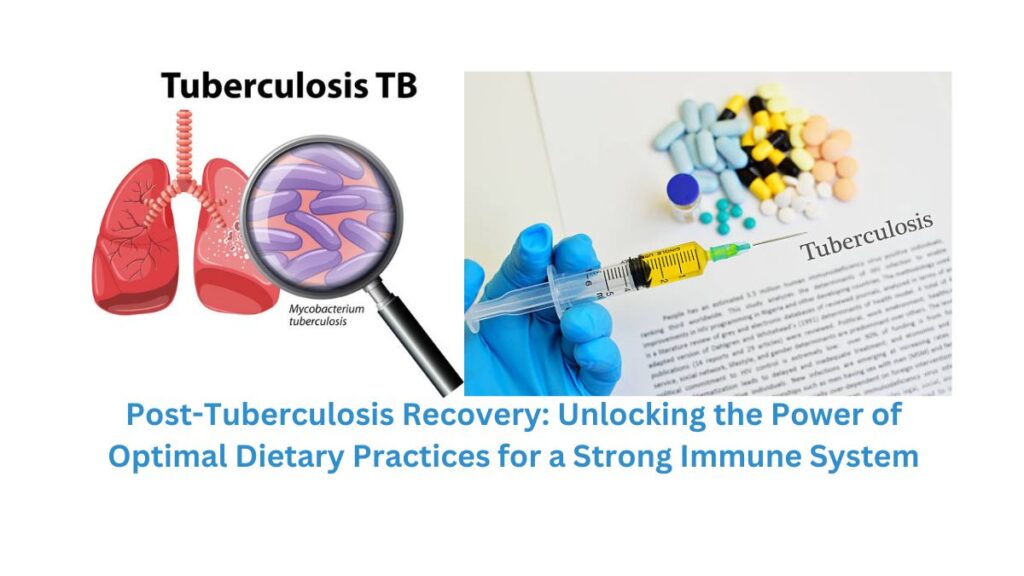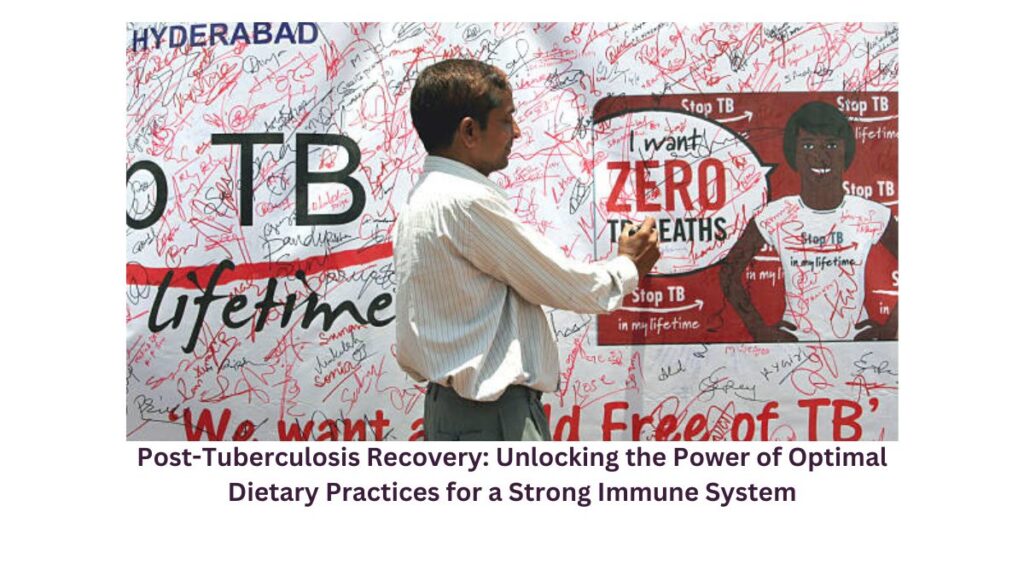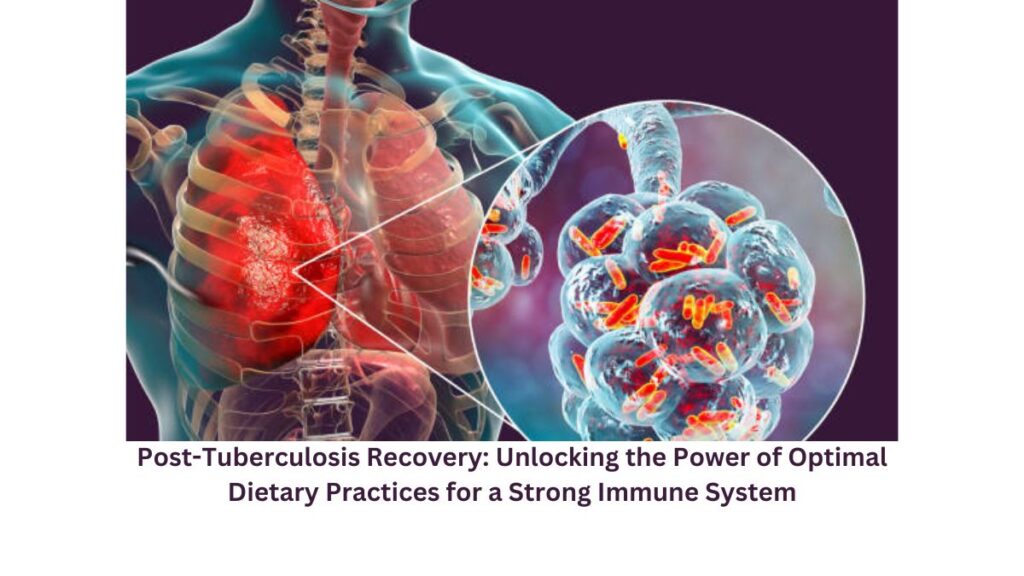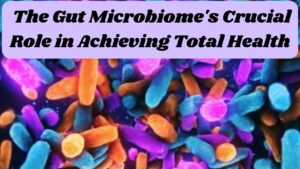Introduction:-
Post-Tuberculosis Recovery: Unlocking the Power of Optimal Dietary Practices for a Strong Immune System

After successfully overcoming tuberculosis, the journey to complete health doesn’t end – it’s time to focus on rebuilding and fortifying your immune system. In this article, we’ll delve into the essential dietary practices that can play a pivotal role in enhancing your immune strength post-tuberculosis recovery.
“What are the essential dietary practices that play a pivotal role in enhancing immune strength during the post-tuberculosis recovery period?”

- Understanding the Impact of Tuberculosis on Immunity: We’ll start by exploring how tuberculosis affects the immune system and why targeted dietary practices become crucial during the recovery phase.
- The Role of Nutrition in Immune Support: Dive into the connection between nutrition and immune health, highlighting key nutrients and their impact on strengthening the body’s defenses.
- Protein-Rich Diet for Recovery: Explore the significance of protein in rebuilding tissues and supporting the immune system. Discover sources of high-quality proteins suitable for post-tuberculosis recovery.
- Incorporating Immune-Boosting Vitamins and Minerals: Uncover the specific vitamins and minerals essential for immune function and learn how to incorporate them into your daily diet effectively.
- Hydration and Detoxification: Discuss the importance of staying hydrated and the role of detoxification in supporting the body’s recovery journey. Provide practical tips for maintaining proper hydration levels.
- Embracing a Balanced Diet: Highlight the significance of a well-balanced diet and the variety of nutrients needed for overall health. Showcase a sample meal plan tailored for post-tuberculosis recovery.
- Avoiding Immune-Compromising Habits: Explore lifestyle habits that may compromise immune function and provide guidance on steering clear of them for optimal recovery.
- Holistic Approaches to Immune Wellness: Discuss complementary practices such as stress management, adequate sleep, and gentle exercise, emphasizing their contribution to a robust immune system.
- Monitoring and Adjusting Your Dietary Plan: Guide readers on how to monitor their progress and make necessary adjustments to their dietary plan based on individual needs and responses.
- Consulting with Healthcare Professionals: Stress the importance of consulting healthcare professionals, such as nutritionists or dietitians, for personalized advice and guidance tailored to individual recovery journeys.
What should you eat after TB treatment?
Recovering from tuberculosis (TB) requires a well-balanced and nutritious diet to support the body’s healing process. While individual dietary needs may vary, here are general guidelines on what to eat after TB treatment:
- Protein-Rich Foods:
- Include lean protein sources such as poultry, fish, eggs, beans, lentils, and tofu to aid in tissue repair and immune system function.
- Whole Grains:
- Opt for whole grains like brown rice, quinoa, and whole wheat, providing essential nutrients and fiber for energy and digestion.
- Fruits and Vegetables:
- Consume a variety of colorful fruits and vegetables rich in vitamins, minerals, and antioxidants. These support overall health and aid in recovery.
- Dairy or Dairy Alternatives:
- Incorporate dairy products or fortified alternatives for calcium and vitamin D to promote bone health, especially if TB has affected the lungs.
- Healthy Fats:
- Include sources of healthy fats such as avocados, nuts, seeds, and olive oil to support nutrient absorption and provide essential fatty acids.
- Iron-Rich Foods:
- Combat anemia with iron-rich foods like lean meats, poultry, fish, beans, lentils, and fortified cereals.
- Vitamin C Sources:
- Enhance iron absorption by including fruits high in vitamin C, such as citrus fruits, strawberries, and bell peppers.
- Probiotic-Rich Foods:
- Support gut health with yogurt, kefir, or other fermented foods containing probiotics.
- Hydration:
- Drink plenty of water to stay hydrated and aid in the elimination of toxins.
- Small, Frequent Meals:
- Consider consuming smaller, more frequent meals to manage appetite and promote efficient digestion.
It’s crucial to consult with healthcare professionals, such as a nutritionist or dietitian, to tailor dietary recommendations to individual needs and health status. They can provide personalized advice based on factors like weight, nutritional deficiencies, and any lingering effects of TB treatment. Additionally, individuals with specific dietary restrictions or underlying health conditions should seek guidance to ensure a well-rounded and suitable post-TB treatment diet.
How can I strengthen my lungs after TB?
Strengthening your lungs after recovering from tuberculosis (TB) is essential for overall respiratory health. Here are some practical steps you can take to support lung strength and recovery:

- Deep Breathing Exercises:
- Practice deep breathing exercises regularly to improve lung capacity and function. Diaphragmatic breathing, pursed lip breathing, and belly breathing can be beneficial.
- Lung Exercises:
- Perform exercises that specifically target the respiratory muscles, such as inspiratory muscle training. These exercises help enhance the strength and endurance of the muscles involved in breathing.
- Cardiovascular Exercise:
- Engage in moderate aerobic exercise, such as walking, cycling, or swimming, to improve overall cardiovascular health and lung function. Start gradually and increase intensity as your fitness improves.
- Yoga and Tai Chi:
- Participate in activities like yoga or tai chi, which emphasize controlled breathing, gentle movements, and relaxation. These practices can enhance lung function and reduce stress.
- Avoid Smoking and Secondhand Smoke:
- Smoking can further damage the lungs and hinder the healing process. If you smoke, seek support to quit, and avoid exposure to secondhand smoke.
- Maintain a Healthy Diet:
- Consume a balanced diet rich in nutrients that support lung health, such as antioxidants, vitamins, and minerals. Include fruits, vegetables, whole grains, and lean proteins in your meals.
- Stay Hydrated:
- Drink an adequate amount of water to maintain optimal lung function and keep mucus membranes in the respiratory tract hydrated.
- Posture and Body Mechanics:
- Focus on maintaining good posture to allow for optimal lung expansion. Practice proper body mechanics during daily activities to avoid straining the respiratory muscles.
- Regular Check-ups:
- Schedule regular check-ups with your healthcare provider to monitor lung function and address any concerns promptly.
- Breathing Exercises During Activities:
- Incorporate proper breathing techniques during daily activities and exercises. Pay attention to your breath and ensure that you are breathing deeply and efficiently.
Always consult with your healthcare provider before starting any new exercise or lifestyle changes, especially after recovering from TB. They can provide personalized advice based on your health status and guide you on the most suitable activities for your specific situation.
Conclusion:
In the aftermath of tuberculosis, prioritizing optimal dietary practices is a key step towards achieving a strong and resilient immune system. By implementing these strategies, individuals can embark on a journey of post-recovery wellness, ensuring their immune defenses are fortified for a healthier future.







